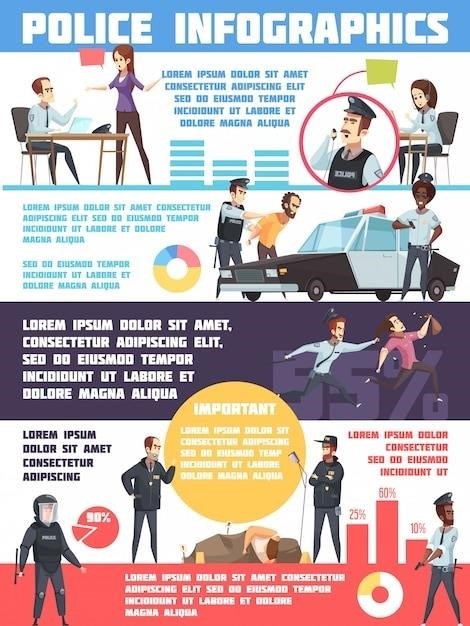A comprehensive Church Security Team Manual PDF provides a structured approach to ensuring the safety and security of your church community. It outlines essential procedures, policies, and best practices for creating a secure environment for members, staff, and guests.
Introduction
In today’s world, churches face a growing need for comprehensive security measures to protect their members, staff, and guests. A well-crafted Church Security Team Manual PDF serves as a vital resource for establishing a proactive and effective security program. This manual provides a framework for developing policies, procedures, and training protocols that address potential threats and vulnerabilities. It empowers church leaders and security teams to create a safe and welcoming environment for all who attend. The manual’s purpose is to guide churches in establishing a robust security plan that prioritizes safety and security without compromising the spirit of hospitality and community that defines a church.

Importance of Security Plans
A comprehensive security plan is not merely a checklist of measures but a fundamental element of responsible church leadership. It demonstrates a commitment to the well-being of the congregation and fosters a sense of safety and security within the church community. A well-defined plan helps mitigate risks, prevent incidents, and ensure an appropriate response in the event of an emergency. It provides a framework for training, communication, and collaboration among security personnel, staff, and volunteers. A robust security plan also serves as a valuable tool for communicating with local authorities and emergency responders, facilitating efficient collaboration in times of crisis.
Key Components of a Church Security Manual
A comprehensive church security manual should encompass a range of critical elements that address various aspects of safety and security. It should outline a clear structure for the security team, defining roles, responsibilities, and reporting lines. It must detail emergency response procedures, including protocols for handling incidents like medical emergencies, active shooter situations, or natural disasters. The manual should also include a thorough risk assessment, identifying potential threats and vulnerabilities, and outlining mitigation strategies. Finally, it should address security technology and equipment, specifying the types of systems and devices used for monitoring, access control, and communication, along with their proper operation and maintenance procedures.

Security Team Structure and Responsibilities
The Church Security Team Manual PDF should clearly define the structure and responsibilities of the security team. This includes establishing a chain of command, assigning specific roles, and outlining reporting procedures. The manual should describe the different roles within the team, such as team leader, security officers, first responders, and communication specialists. Each role should have clearly defined responsibilities, including tasks like monitoring security systems, conducting patrols, managing access control, responding to incidents, and coordinating with local authorities. The manual should also outline training requirements for each role, ensuring team members are equipped with the necessary skills and knowledge to effectively carry out their duties.
Emergency Response Procedures
The Church Security Team Manual PDF should detail comprehensive emergency response procedures; This includes defining specific protocols for different scenarios, such as active shooter incidents, medical emergencies, natural disasters, and security breaches. The manual should outline the steps involved in initiating an emergency response, including identifying the threat, activating emergency protocols, notifying authorities, and evacuating or sheltering in place. It should also cover communication procedures, ensuring clear and timely communication between security team members, church staff, and emergency responders. The manual should include detailed instructions for handling specific emergencies, including first aid procedures, crowd control techniques, and procedures for securing the church building and grounds.
Risk Assessment and Mitigation
A comprehensive Church Security Team Manual PDF should include a dedicated section on risk assessment and mitigation. This section should guide the team in identifying potential threats and vulnerabilities within the church environment. This could include analyzing the church’s physical layout, identifying potential entry points, assessing the security of parking areas, and evaluating the effectiveness of existing security measures. The manual should also outline strategies for mitigating identified risks, such as implementing access control measures, installing security cameras, training security personnel, and developing emergency response plans. The team should conduct regular risk assessments to identify emerging threats and adjust security procedures accordingly. By proactively addressing potential risks, the church can create a safer and more secure environment for everyone.
Security Technology and Equipment
The Church Security Team Manual PDF should provide guidance on the selection, installation, and use of security technology and equipment. This section should cover a range of technologies, including security cameras, access control systems, alarm systems, and communication devices. The manual should outline the specific features and capabilities of each technology, as well as the best practices for their deployment and maintenance. It is crucial to ensure that all security equipment meets industry standards and is properly integrated with the church’s overall security plan. The manual should also provide information on the legal considerations related to the use of surveillance technology, including data privacy and compliance with relevant regulations. By incorporating appropriate security technology and equipment, the church can enhance its security posture and create a safer environment for everyone.
Developing Your Security Team
A well-trained and dedicated security team is crucial for a safe and secure church environment. The Church Security Team Manual PDF should provide a detailed guide to developing and managing this team. This section should cover the recruitment process, outlining the necessary qualifications and skills for security team members. It should also address the importance of background checks and reference checks to ensure the suitability of candidates. The manual should emphasize the need for comprehensive training programs that cover topics such as emergency response procedures, crowd control techniques, conflict resolution skills, and basic first aid. It is essential to provide ongoing training and development opportunities to keep the team updated on the latest security practices and procedures. Regular drills and simulations can help the team to stay prepared and enhance their response capabilities.
Recruitment and Training
The Church Security Team Manual PDF should provide comprehensive guidelines for recruiting and training a competent security team. The manual should emphasize the importance of selecting individuals who possess a strong moral character, a commitment to serving the church, and a genuine concern for the safety and well-being of others. The recruitment process should involve a thorough background check and reference check to ensure the suitability of each candidate. Once the team is assembled, the manual should outline a comprehensive training program that addresses various aspects of security, including emergency response procedures, crowd control techniques, basic first aid, and conflict resolution skills. Regular drills and simulations should be incorporated into the training program to enhance the team’s preparedness and response capabilities.
Ongoing Training and Development
The Church Security Team Manual PDF should emphasize the importance of ongoing training and development for security team members. This section should address the need for regular refresher courses, updates on security protocols, and training on emerging threats and best practices. The manual should also include a plan for the team to participate in external training programs offered by security professionals or law enforcement agencies. This ongoing training ensures that the team remains proficient in their skills, stays abreast of current security trends, and maintains a high level of preparedness to respond effectively to potential threats. The manual should also highlight the importance of fostering a culture of continuous learning and professional development within the security team.
Resources and Best Practices
The Church Security Team Manual PDF should provide a valuable resource section for church security teams. This section should outline recommended resources, best practices, and essential information for enhancing security protocols. It should include links to relevant websites, organizations, and publications specializing in church security. The manual should also include information on legal considerations, compliance requirements, and relevant laws and regulations related to church security. This section can serve as a valuable resource for church security teams, enabling them to access the latest information, best practices, and support for maintaining a safe and secure environment within the church community.
Sample Security Manuals and Templates
The Church Security Team Manual PDF should include a section dedicated to providing access to sample security manuals and templates. These resources can serve as valuable guides for churches in developing their own comprehensive security plans. Sample manuals can offer a framework for outlining policies, procedures, and responsibilities. Templates for specific security documents, such as emergency response plans, risk assessments, and training materials, can streamline the process of creating these essential components. By providing access to these readily available resources, the manual empowers churches to establish effective security practices while tailoring them to their unique needs and circumstances.
Church Security Organizations and Associations
A valuable resource for churches developing a security team and manual is connecting with established Church Security Organizations and Associations. These organizations offer a wealth of knowledge, expertise, and support to churches seeking to enhance their security measures. They often provide training programs, best practice guidelines, and networking opportunities for security teams. By engaging with these associations, churches can gain access to a collective pool of experience, stay informed about emerging security threats, and receive guidance on implementing effective security strategies. These connections are crucial for fostering a culture of safety and security within the church community.
Legal Considerations and Compliance
The development of a Church Security Team Manual must carefully consider legal considerations and compliance requirements. Understanding local laws, regulations, and guidelines related to security practices, emergency procedures, and the use of security technology is crucial. The manual should outline procedures for handling incidents, reporting crimes, and cooperating with law enforcement agencies. It should also address the legal aspects of data privacy and security, ensuring compliance with relevant regulations like the General Data Protection Regulation (GDPR) or other applicable data protection laws. Consulting with legal professionals specializing in church security and data protection can provide valuable guidance on navigating these complexities and ensuring the church is operating within legal frameworks.
A well-crafted Church Security Team Manual PDF serves as a valuable resource for establishing a secure and welcoming environment for your church community. It provides a framework for organizing your security efforts, outlining roles and responsibilities, and ensuring consistent procedures in handling emergencies and potential threats. By investing time and resources in developing a comprehensive manual, churches can proactively address security concerns, foster a sense of safety and security among members, and create a space where everyone can worship and gather with peace of mind. Regular review and updates to the manual are essential to ensure it remains relevant and effective in meeting evolving security needs.
